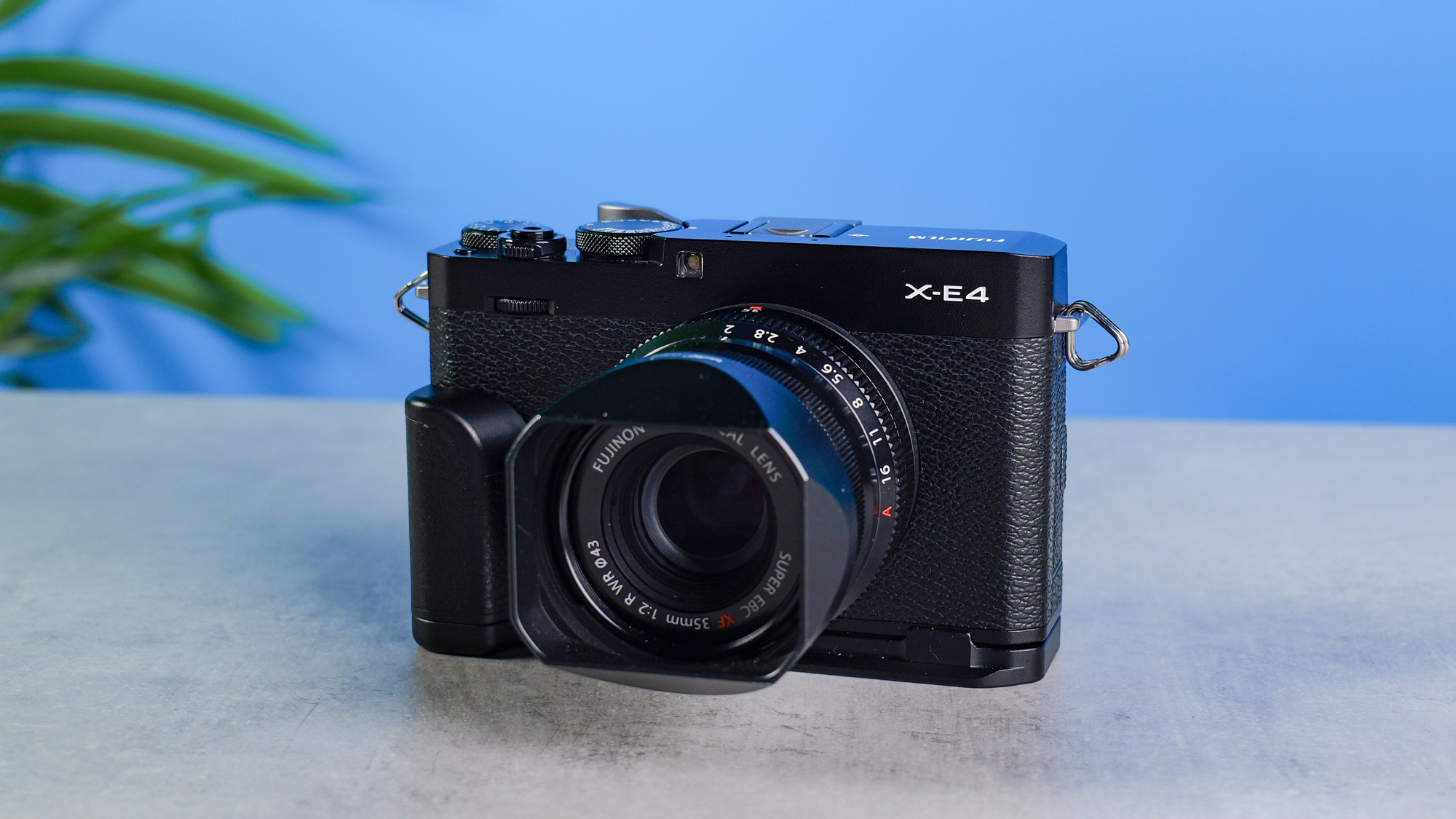Google Pixel 6 Pro vs. OnePlus 9 Pro: Which Android phone wins?
Here's how these two premium Android phones stack up
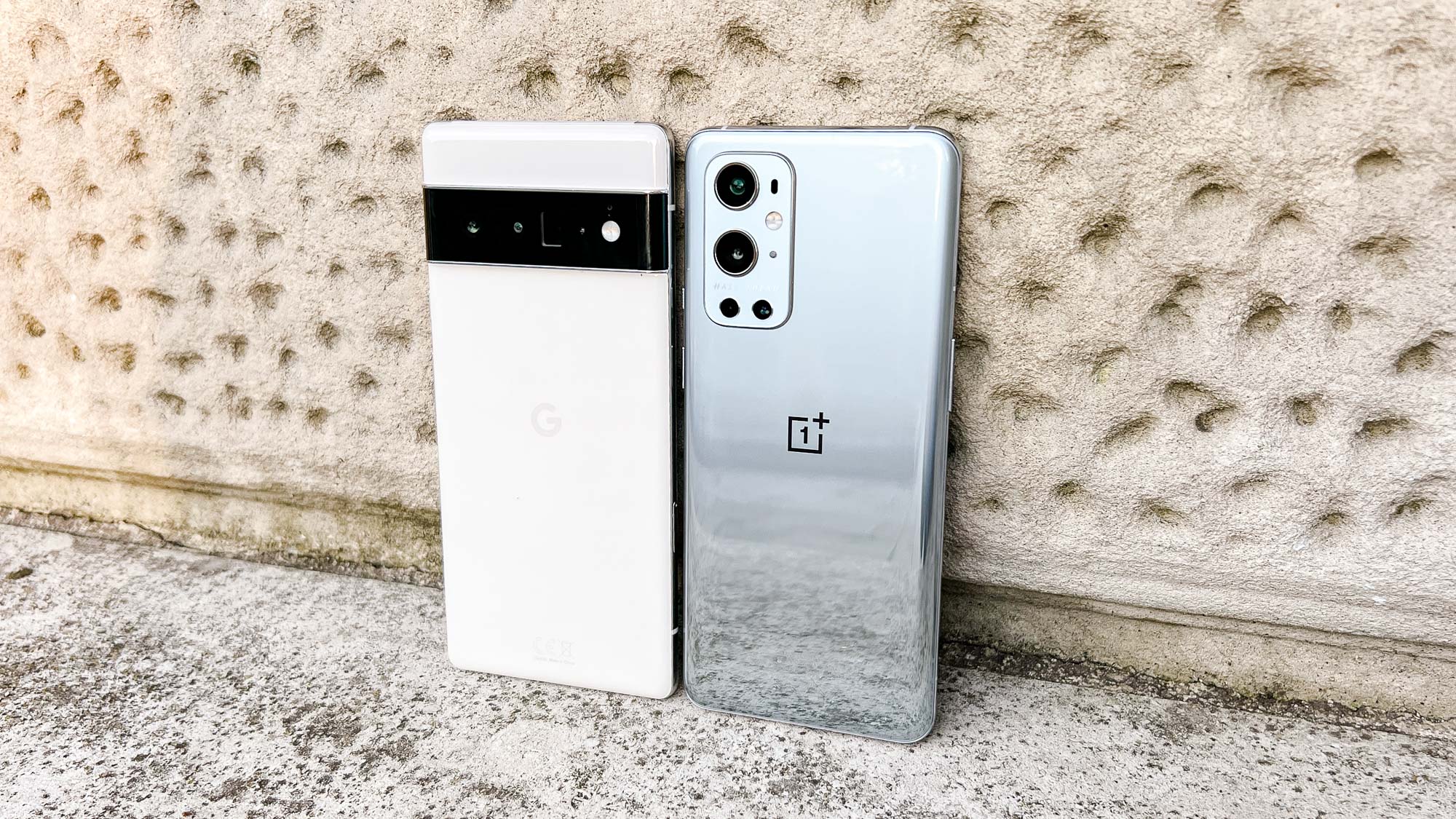
The battle between the Google Pixel 6 Pro and the OnePlus 9 Pro is one of the most surprising smartphone contests of the year. While many default to a certain Korean company for their Android flagship needs, Google and OnePlus have both put up impressive alternatives that deserve your attention.
The Pixel 6 Pro and OnePlus 9 Pro represent a huge step up for each phone maker. OnePlus put its focus on improving the cameras in the OnePlus 9 Pro while still trying to undercut rivals for hardware value. Meanwhile, Google transformed its flagship Pixel into a near-unrecognizable new device with top-class components and its own proprietary chipset.
- See where both phones land on our best Android phones guide
- Google Pixel 6 Pro vs Samsung Galaxy S21 Ultra: Which phone wins?
- Best Google Pixel 6 Pro cases
Putting the two phones against each other results in a lot of categories with close contests, though the key strengths and weaknesses of both phones also emerge. And that can help you decide which phone to spend your money on.
Read on for the full breakdown of our Google Pixel 6 Pro vs. OnePlus 9 Pro face-off.
Google Pixel 6 Pro vs. OnePlus 9 Pro: Specs
| Row 0 - Cell 0 | Google Pixel 6 Pro | OnePlus 9 Pro |
| Starting price | $899/£849 | $969/£829 |
| Screen size | 6.71-inch OLED QHD+ (3,120 x 1,440) | 6.7-inch AMOLED QHD+ (3,168 x 1,440) |
| Refresh rate | 120Hz (adaptive) | 120Hz (adaptive) |
| Rear cameras | 50MP main, 12MP ultrawide, 48MP telephoto (4x optical zoom) | 48MP main, 50MP ultrawide, 8MP telephoto (3.3x optical zoom), monochrome |
| Front camera | 11MP | 16MP |
| Chipset | Google Tensor | Qualcomm Snapdragon 888 |
| RAM | 12GB | 8GB/12GB |
| Storage | 128GB, 256GB, 512GB | 128GB, 256GB |
| Battery size | 5,000 mAh | 4,500 mAh |
| Battery life (hrs:mins) | 7:49 (adaptive) / 7:55 (60Hz) | 10:40 (adaptive) / 10:38 (60Hz) |
| Charging speed | 30W wired, 23W wireless | 65W wired, 50W wireless |
| Size | 6.5 x 3.0 x 0.4 inches | 6.4 x 2.9 x 0.34 inches |
| Weight | 7.4 ounces | 6.9 ounces |
Google Pixel 6 Pro vs. OnePlus 9 Pro: Price
Both of these phones fall on the cheaper side of Android flagships, but the Pixel 6 Pro is still the better deal. It starts at $899/£849 for the 128GB version, and goes up to $999/£949 for 256GB storage and $1,099 for 512GB storage. Note however the version you buy from certain U.S. carriers may cost a little more, likely due to the expense of added mmWave 5G support.
The OnePlus 9 Pro's cheapest 8GB RAM and 128GB storage version goes for $969/£829, and costs $1,069/£929 if you want 12GB RAM and 256GB storage instead. This makes the OnePlus 9 Pro the better deal between it and the Pixel 6 Pro in the U.K., assuming you don't mind the lack of RAM, but an inferior choice for the price in the U.S.
Winner: Draw
Get instant access to breaking news, the hottest reviews, great deals and helpful tips.
Google Pixel 6 Pro vs. OnePlus 9 Pro: Design
There are some similarities in the look of the two phones, but where the Pixel 6 Pro and OnePlus 9 Pro differ, they really differ.

Both phones measure 6.7 inches, and feature punch-hole selfie cameras. The power and volume buttons on the Pixel are all on the right side, whereas the OnePlus keeps its volume button on the left side, and adds its trademark alert slider to the right for convenient switching between normal, vibrate and silent profiles.
Turn the phones over and you'll find two very different designs. The OnePlus looks like a normal Android phone, with a rectangular camera block in the top left corner and a uniform glass body. The Pixel however features a camera bar across the whole width of the phone about a third of the way up, with the body above being a matte version of your selected color and the body below being the glossy version.
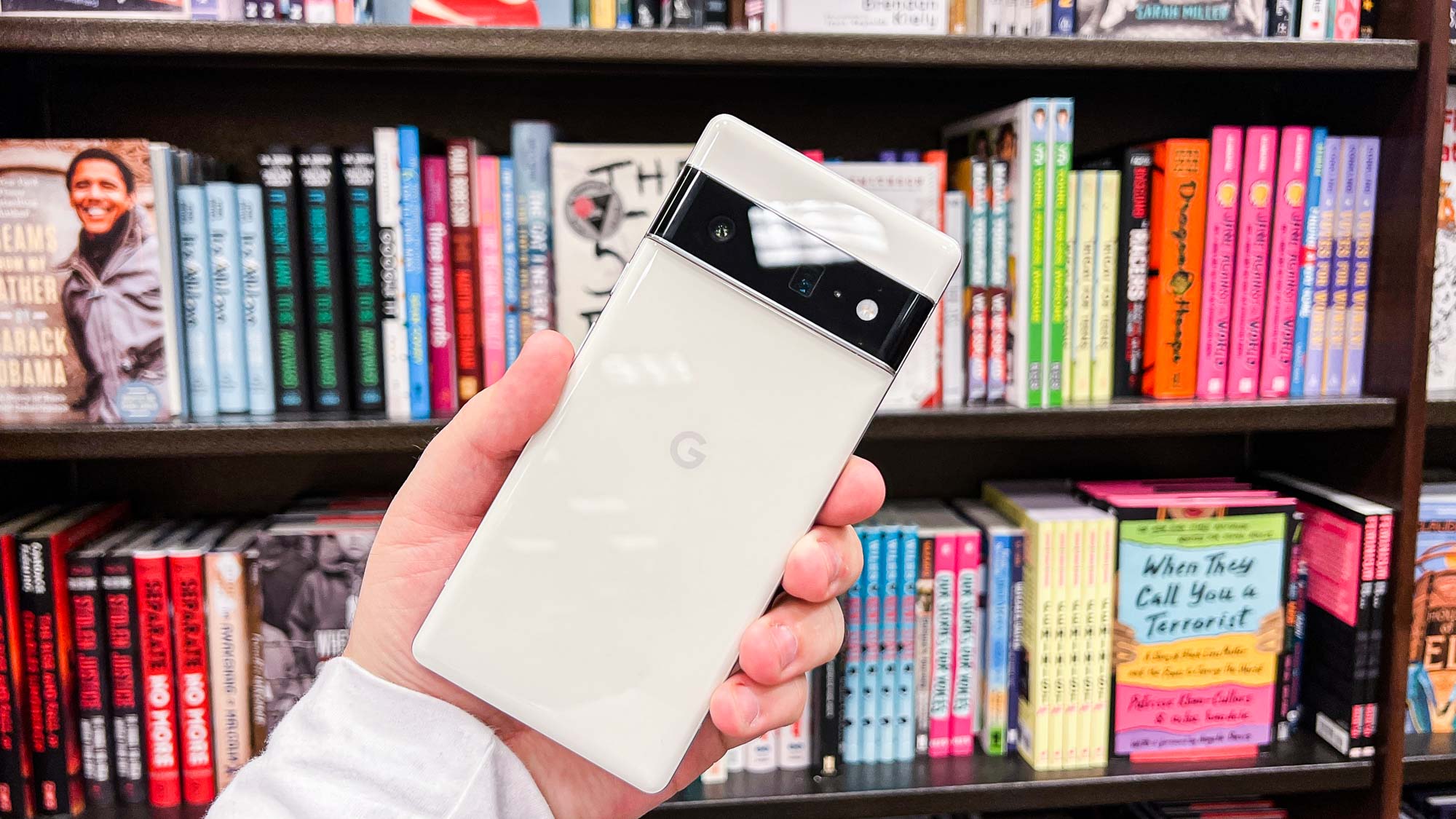
In practical terms, there are a few notable differences. There's a 0.5 ounce /13 gram weight difference between the two phones — the OnePlus 9 Pro is the lighter of the two devices. OnePlus' phone is also a little bit slimmer.
While both phones use toughened glass on the front and back, the Pixel 6 Pro features a Gorilla Glass Victus display and a Gorilla Glass 6 back, superior to the Gorilla Glass 5 build of the OnePlus 9 Pro. That should mean the Pixel 6 will shrug off drops and scratches better than the OnePlus will, at least in theory.
Both devices tout IP68 resistance against water and dust intrusion, the gold standard for smartphones right now.
This round was close, given that design often comes down to personal preference. However we think Google just edges out a victory for breaking out of the current Android design trends, and for offering tougher materials.
Winner: Google Pixel 6 Pro
Google Pixel 6 Pro vs. OnePlus 9 Pro: Display
You have really sweat the details to find the differences between these two phones' displays. Both offer great OLED screens, measuring 6.7 inches diagonally with QHD resolutions and LTPO 120Hz refresh rates.
According to our test results however, the OnePlus 9 Pro comes out ahead for color accuracy and saturation, while the Pixel 6 Pro wins for a higher average brightness.
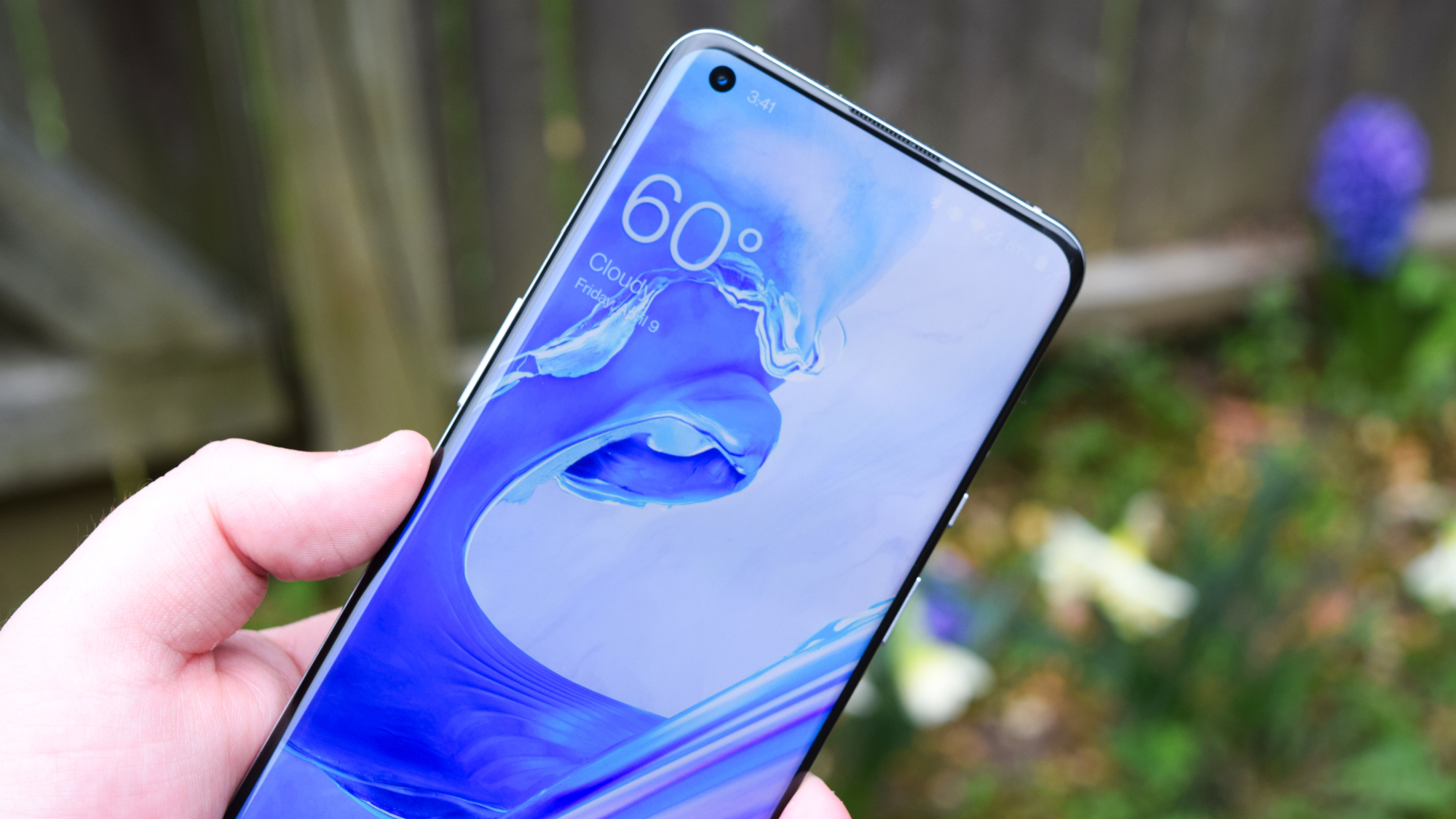
While both phones have curved left and right sides, the curve of the Pixel 6 Pro is slightly more extreme. That may prove irritating for some users as curved screens can be prone to accidental touches than flat panels.
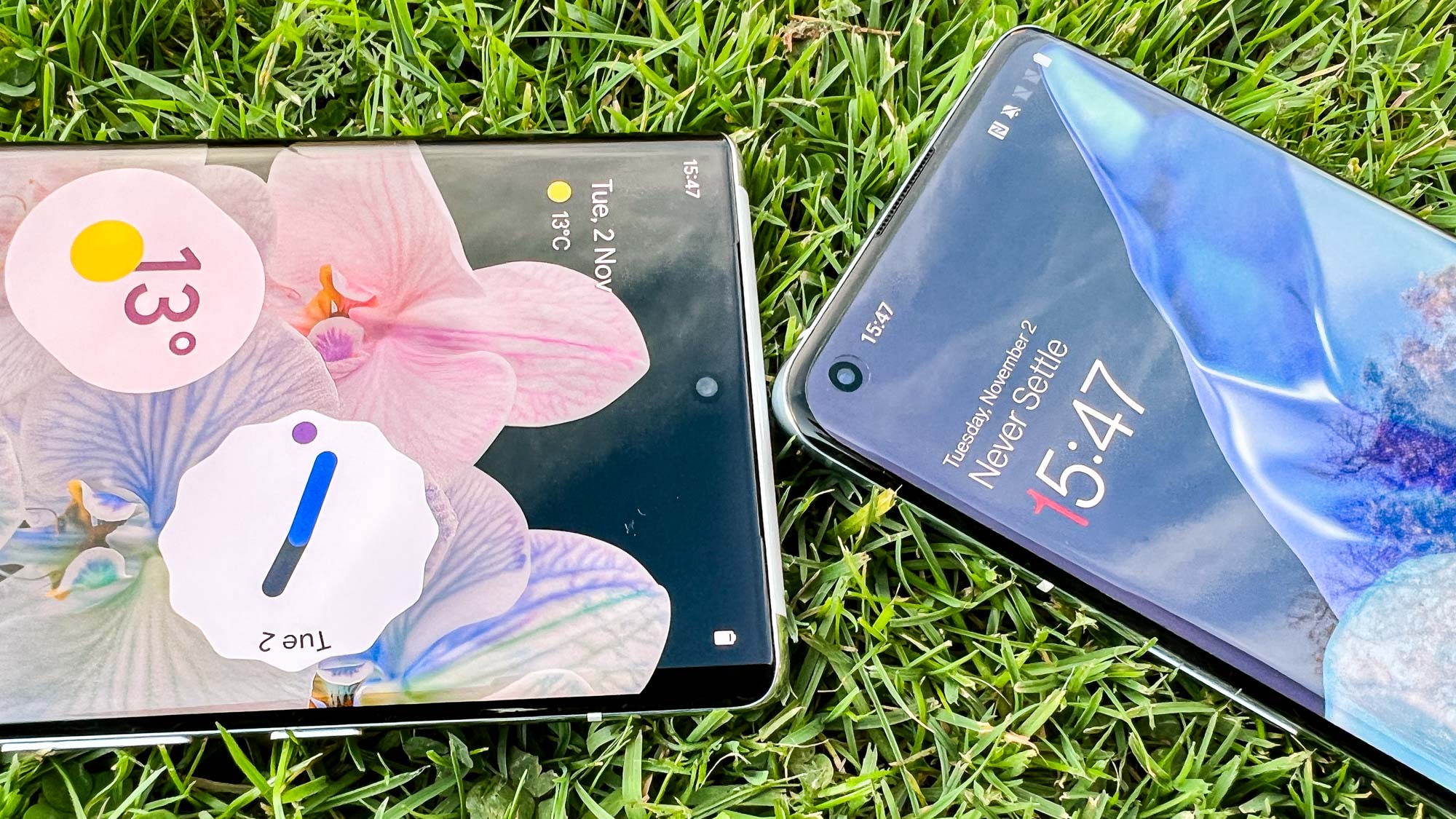
While you can point to differences between the two phones if you have thousands of dollars of precise lab equipment, there's not really a clear winner here if you're a typical user.
Winner: Draw
Google Pixel 6 Pro vs. OnePlus 9 Pro: Cameras
Photography is a crucial category for smartphones, and from a specs perspective, you could call it either way in a Google Pixel 6 Pro vs. OnePlus 9 Pro showdown The OnePlus 9 Pro features four rear cameras: a 48MP main camera, a 50MP ultrawide camera, an 8MP telephoto camera with 3.3x optical zoom and a 2MP monochrome camera.
In contrast, the Pixel 6 Pro gets a 50Mp main camera, a 12MP ultrawide camera and a 48MP telephoto camera with 4x optical zoom. So while the OnePlus in theory does better on the ultrawide front, and boasts an extra sensor, the Pixel has a megapixel advantage for the main and telephoto cameras, plus a higher magnification for the zoom lens.
To put these cameras in a head-to-head, I took a late afternoon trip to London's Hyde Park. This shot of a fountain from the park's Italian Gardens looks warmer in the OnePlus' image, while it looks far more wintery in the Pixel's. However the clincher here is the increased definition in the Pixel 6 Pro's picture. The enhanced lines in the marble and the more defined water droplets in the fountain's spray make it my favorite of the two.

While I was here, I also took a picture with the OnePlus 9 Pro's mono camera. This particular sensor doesn't take pictures by itself, but instead enhances the images you take with the main camera using the mono filter within the OnePlus camera app. In theory using the extra sensor helps bring extra definition into these black-and-white images, but personally I don't see much of a difference.
With a nighttime photo opportunity at St. Mary's Church, Marylebone, we see that once again, the OnePlus 9 Pro's image is brighter than the Pixel 6 Pro's. It's also more saturated, which gives the sky and brickwork in the 9 Pro's image a striking look. While I think I prefer the more natural tones produced by the Pixel 6 Pro again, I may have on another day gone for the OnePlus.
Back at Hyde Park, I used the two phones' ultrawide sensors to fit the whole of the Italian Gardens' pavilion in frame. This was easier on the OnePlus 9 Pro, since its ultrawide lens uses 0.6x magnification, while the Pixel 6 Pro has a tighter 0.7x zoom. The color difference we saw in the main camera images has now disappeared, which means the greater detail of the Pixel 6 Pro's image, visible in the carvings and the natural pattern of the stone, gives it the win this time
The last rear camera to test is the telephoto camera with the help of a co-operative swan. The Pixel 6 Pro is far and away the winner here for two reasons. It properly shows the detail in the swan's feathers, which is flattened out in the OnePlus' image. Also, the increased 4x zoom compared to the 3.3x zoom on the OnePlus helps you get closer to your subject without needing to rely on ugly digital zoom.
In terms of special features, the Pixel 6 Pro is stuffed full of them. You've got Magic Eraser to selectively edit out unwanted objects and people in your image, Face Unblur to give detail back to obscured faces, action pan and long exposure Motion modes for capturing dramatic images with moving and stationary objects, and many more handy tools topped off with Google's world-leading photo processing.
The OnePlus on the other hand has a relatively bare box of tools, although it still offers a highly customizable Pro photo mode, up to 8K video recording and a tilt-shift function for unique-looking photos that turn your subject into something resembling a miniature diorama.
On the topic of video, I took both phones for a short walk around Paddington Basin to sample their recording abilities, in particular their stability. Both phones offer more than one stabilization option (the Pixel 6 Pro offers four in fact), but I kept things default for my test.
Walking down the stairs at the east side of the Basin and heading over to the floating pocket park in the center, the OnePlus video sample proved to be a little bouncier than the Pixel's footage. The sound and colors are superior too, meaning it's once again Google's round.
Both phones offer a single selfie camera: an 11MP one in the case of the Pixel 6 Pro and a 16MP for the OnePlus. I gave these both a try in portrait mode, and found a reversal of what we saw earlier: the Pixel 6 with the warmer picture and the OnePlus 9 Pro with a cooler one. The portrait blur effect on the Pixel image's background is stronger too, while also having a better defined border around my head and hair, which is what ultimately convinces me to hand this round to Google.
OnePlus worked hard on improving its camera tech for the OnePlus 9 series with the help of Swedish company Hasselblad, and you can tell that from the fact it was a close call in all but one or two of the above comparisons. However Google has always been strong with photography, and now it's equipped its phone with three top-notch sensors for the first time, it's not surprising that I prefer the Pixel 6 Pro as a camera phone overall.
Winner: Google Pixel 6 Pro
Google Pixel 6 Pro vs. OnePlus 9 Pro: Performance
Google finally took a page out of Apple and Samsung's book this year and developed its own chipset, named Tensor. While it's capable of many clever AI and ML functions, in terms of raw power Tensor's behind what the OnePlus 9 Pro's Snapdragon 888 can achieve.
On the Geekbench 5 CPU benchmark test, the Pixel 6 pots scores of 1,027 (single core) and 2,760 (multi-core). The OnePlus 9 Pro gets 1,126 on the single core test and 3,685 points on the multi-core. It's pretty clear that the Tensor is not made for the same number-crunching that the Snapdragon chip is.
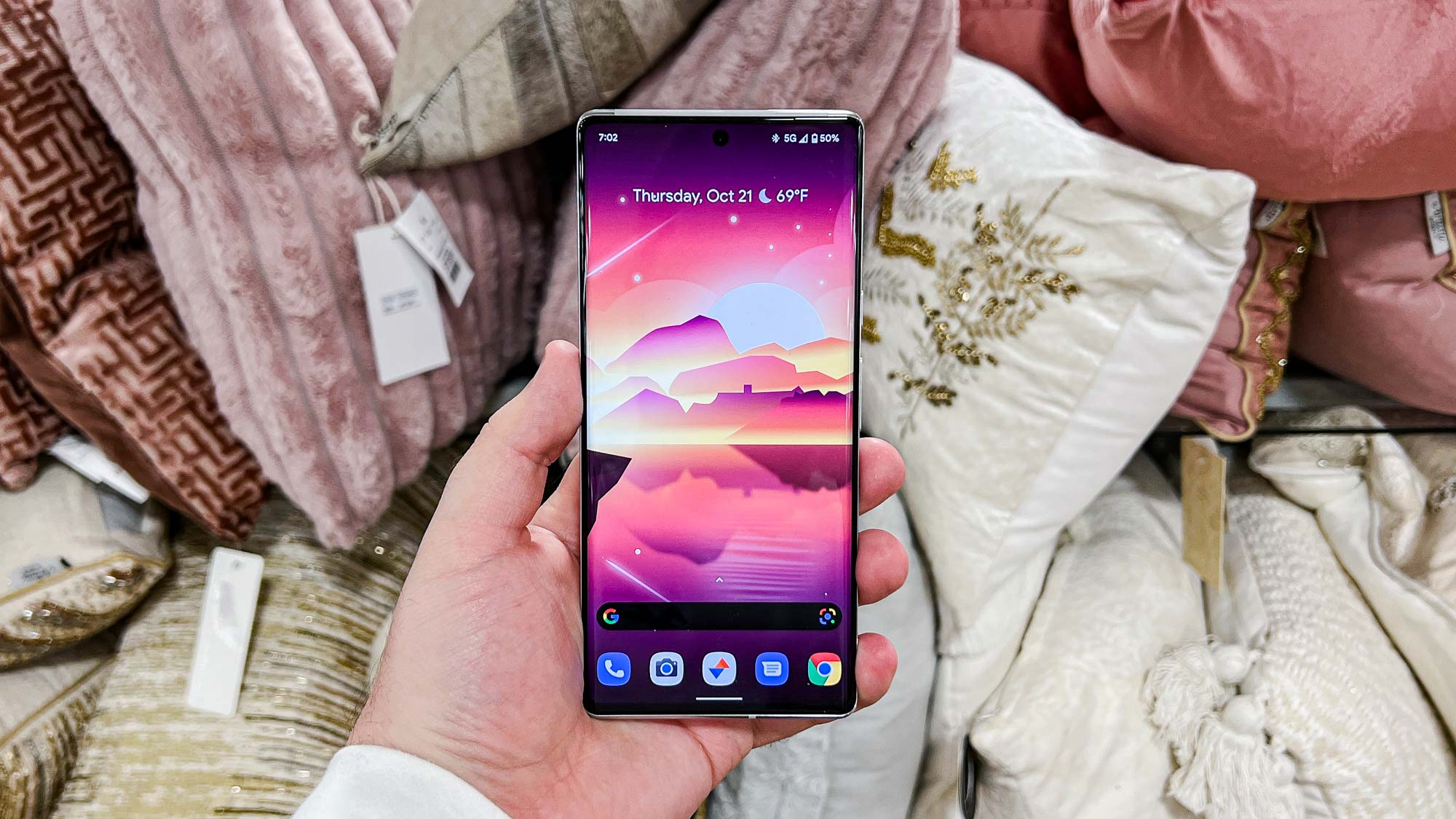
That said, on the Wild Life Unlimited GPU benchmark from 3DMark, the Pixel 6 Pro pulls ahead. It scored 6,682 points on this test, and managed an average frame rate of 40 frames per second. The OnePlus 9 Pro meanwhile got 5,755 points and an average of 34.5fps.
The Pixel 6 Pro also beats the OnePlus 9 Pro when it comes to media transcoding, taking 48 seconds to convert a video from 4K to 1080p with Adobe Premiere Rush. The OnePlus was by no means slow at 1 minute and 2 seconds, but certainly a way behind the Google phone.
Looking at all the tests together, this once more ends up a draw, even though the discrepancy on the CPU benchmark does look pretty bad for the Pixel 6 Pro and the Tensor chip.
Winner: Draw
Google Pixel 6 Pro vs. OnePlus 9 Pro: Battery life and charging
With its 5,000 mAh battery, you'd imagine the Pixel 6 Pro would last a fair bit longer than the OnePlus 9 Pro and its 4,500 mAh cell. But on our custom battery test, which involves repeatedly opening web pages over 5G until the phones run out of power, the Pixel 6 Pro managed to last just 7 hours and 49 minutes with the adaptive 120Hz display on. That's way behind the 10 hours and 40 minutes that the OnePlus 9 Pro achieved, which is better than average for a smartphone though not long enough to land among on our best phone battery life list.
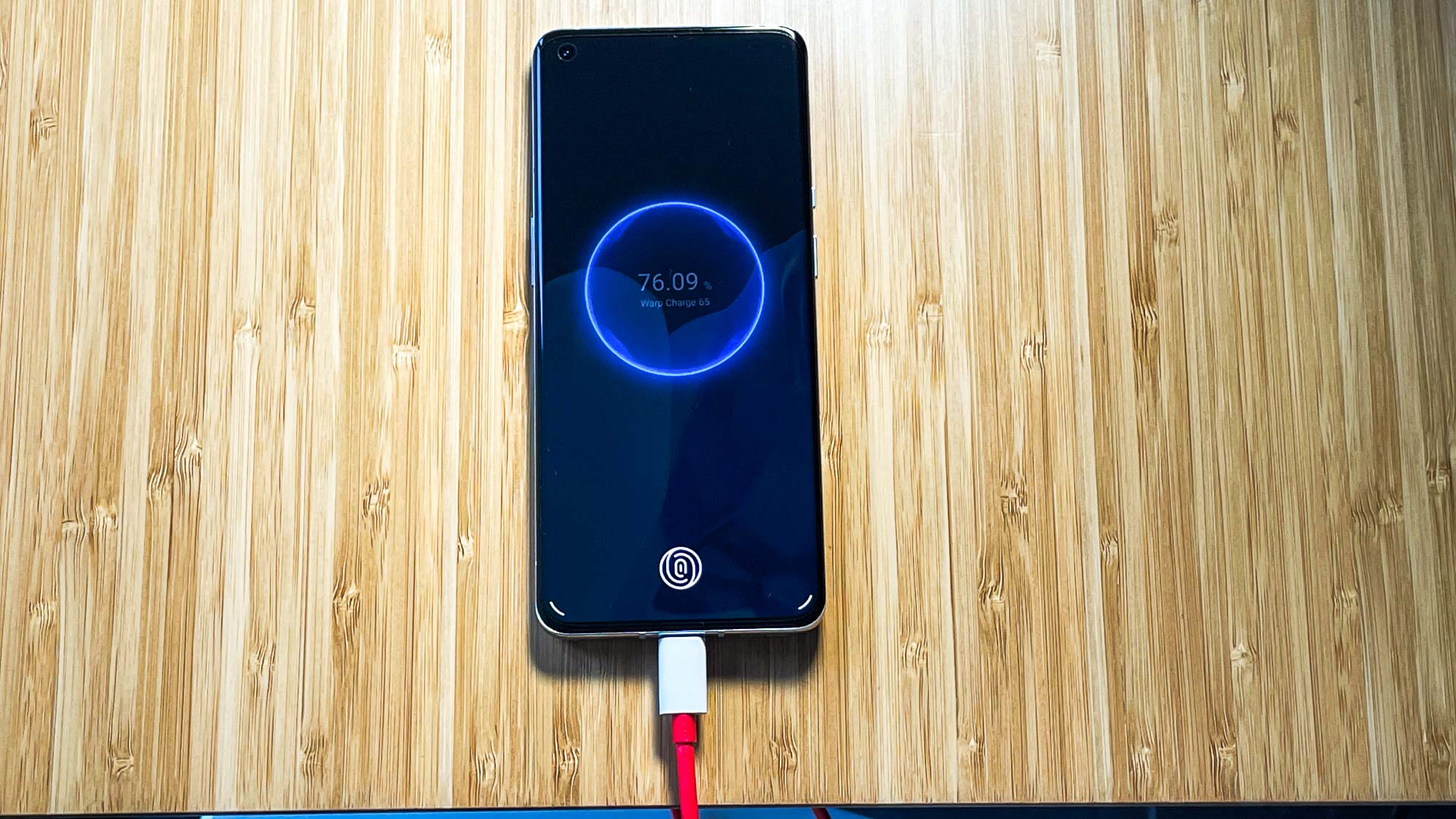
For charging, the OnePlus 9 Pro makes an even stronger case. While Google offers its fastest charging yet with the Google Pixel 6 series, there's no 30W charger included in the box with your phone. Testing with a third-party 30W charger filled the Pixel 6 Pro's battery to 40% in half an hour, which is decent.
But the OnePlus 9 Pro can charge to 99% in the same time with its 65W charger. Combined with the fact that OnePlus includes a charger, you get the maximum charging speed as soon as you get your phone.
While we haven't tested the wireless charging speeds of either phone, the OnePlus in theory wins again here. It offers a maximum of 50W wireless charging, while the Pixel 6 Pro tops out at a mere 23W.
Winner: OnePlus 9 Pro
Google Pixel 6 Pro vs. OnePlus 9 Pro: Software and special features
The Pixel 6 Pro has an advantage when it comes to software goodies since it's not only made by the company that designs its operating system but is also the first phone to ship with the final version of the latest edition: Android 12.
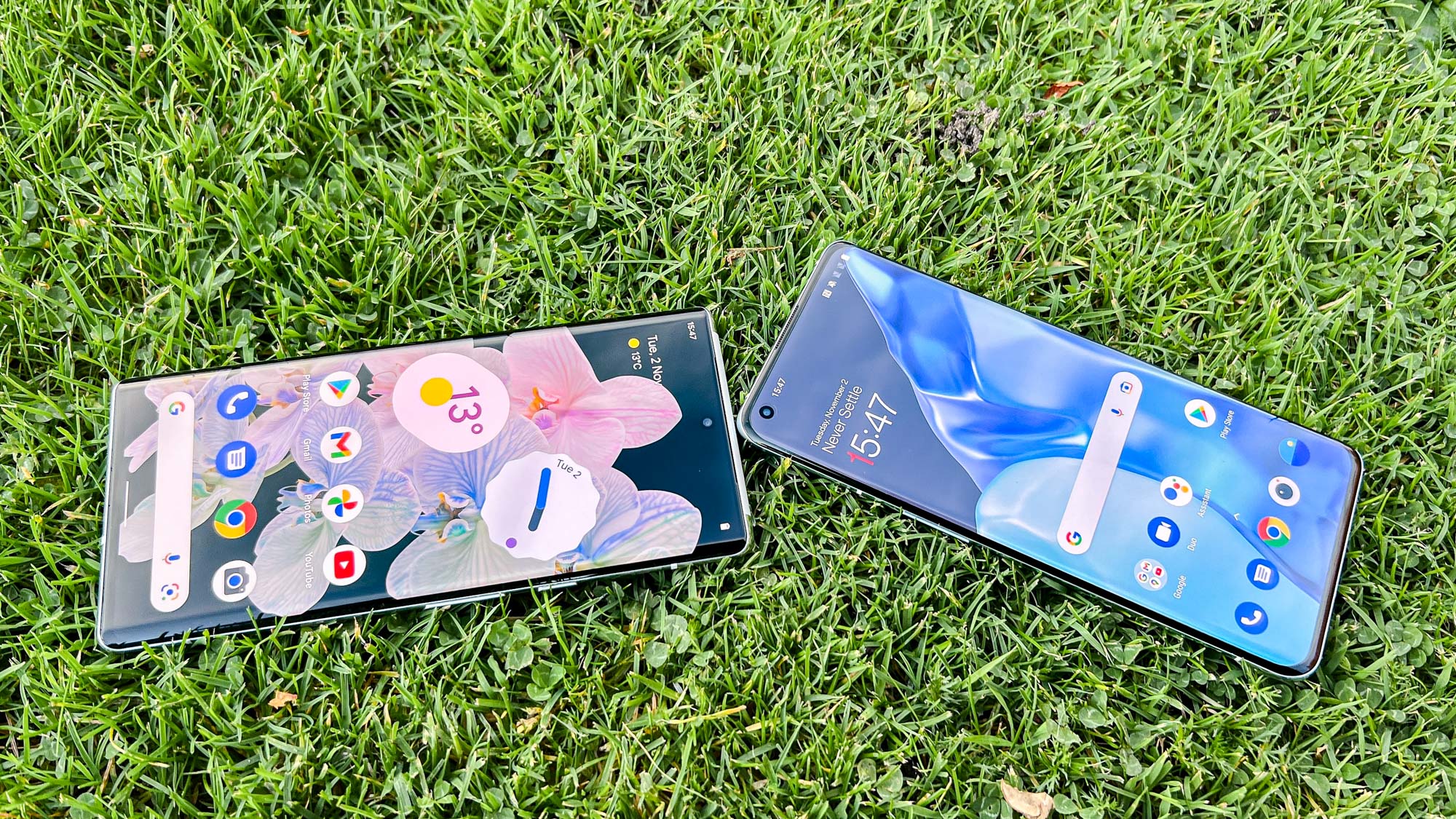
While Android 12 brings lots of enhancements of its own, like the highly customizable Material You design language, the Pixel 6 builds on that with features like At A Glance, which automatically pops up timely notifications like travel tickets, enhanced voice commands for dictation or giving the Google Assistant orders. You also can enjoy live text and audio translation for up to 55 different languages. Google promises that there's even more on the way too, as it plans to continue its "Pixel Drop" updates that add new software features throughout the year.
Now usable with the Android 12-based OxygenOS 12 via OTA update, the OnePlus 9 Pro isn't quite as clever as the Pixel 6 Pro, but still offers some useful tools of its own. The new version of OxygenOS features the Work Life Balance 2.0 mode that alters your phone's notification profile based on your location or time of day, Zen Mode for when you want to force yourself to put your phone down and relax, and a revised version of the "Shelf," a pull-down home screen menu that stores handy widgets and app shortcuts.
Winner: Google Pixel 6 Pro
Google Pixel 6 Pro vs. OnePlus 9 Pro: Verdict
Going by round-by-round wins, the Pixel 6 Pro is our overall favorite of these two phones. However, the scores below reflect just how close this competition really is.
| Row 0 - Cell 0 | Google Pixel 6 Pro | OnePlus 9 Pro |
| Price and value (15 points) | 14 | 13 |
| Design (10 points) | 9 | 7 |
| Display (15 points) | 13 | 13 |
| Cameras (20 points) | 19 | 15 |
| Performance (15 points) | 12 | 12 |
| Special features (10 points) | 9 | 6 |
| Battery life and charging (15 points) | 8 | 14 |
| Overall | 84 | 80 |
The best parts of the Pixel 6 experience are its excellent cameras, impressive software features and to a lesser extent its more compelling design. The OnePlus 9 Pro's lone win in the battery life and charging category is a big deal though, as longevity and charging speed are two things that every potential user will notice.
If your priorities for phone buying revolve around any of the above categories, you probably already know which is your favorite in a Google Pixel 6 Pro vs. OnePlus 9 Pro face-off. For pricing, display quality or performance, it's harder to say which one is best for an individual buyer.
The cheaper phone of the two depends on whether you're in the U.S. or U.K., and the better screen basically comes down to if you prefer more or less curved edges on your handset. As for computing power, the Pixel 6 Pro is deceptively capable at intensive tasks, even if it doesn't look so hot on the benchmarks.
Unless you've already ruled it out, we'd recommend taking a look at the Samsung Galaxy S21 Ultra for another possible Android flagship option. You can read our Google Pixel 6 Pro vs Samsung Galaxy S21 Ultra and OnePlus 9 Pro vs Samsung Galaxy S21 Ultra comparisons for more on how those pairings stack up.
Out of these two phones, though, the Pixel 6 Pro is the one we'd go for.

Richard is based in London, covering news, reviews and how-tos for phones, tablets, gaming, and whatever else people need advice on. Following on from his MA in Magazine Journalism at the University of Sheffield, he's also written for WIRED U.K., The Register and Creative Bloq. When not at work, he's likely thinking about how to brew the perfect cup of specialty coffee.
